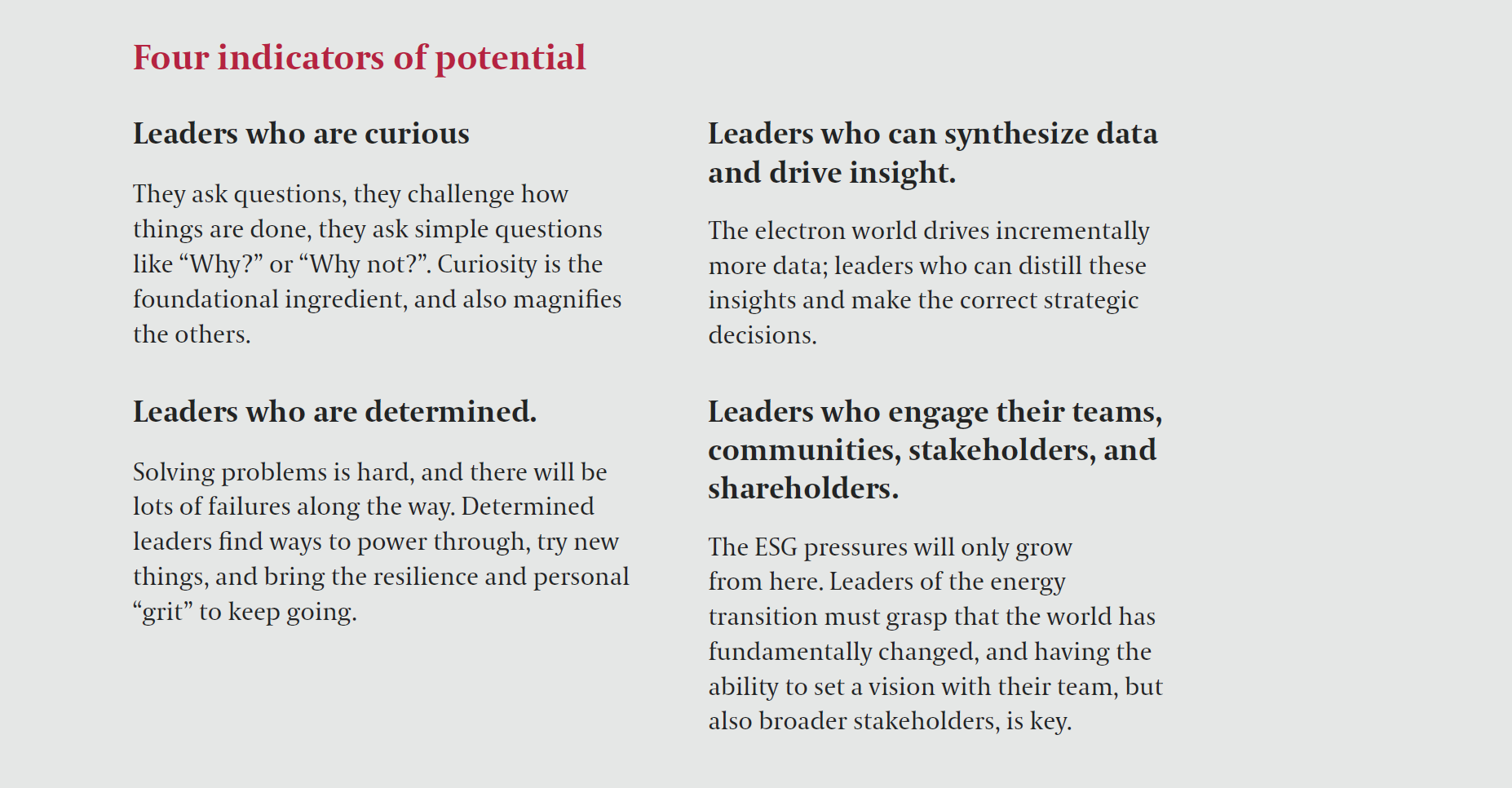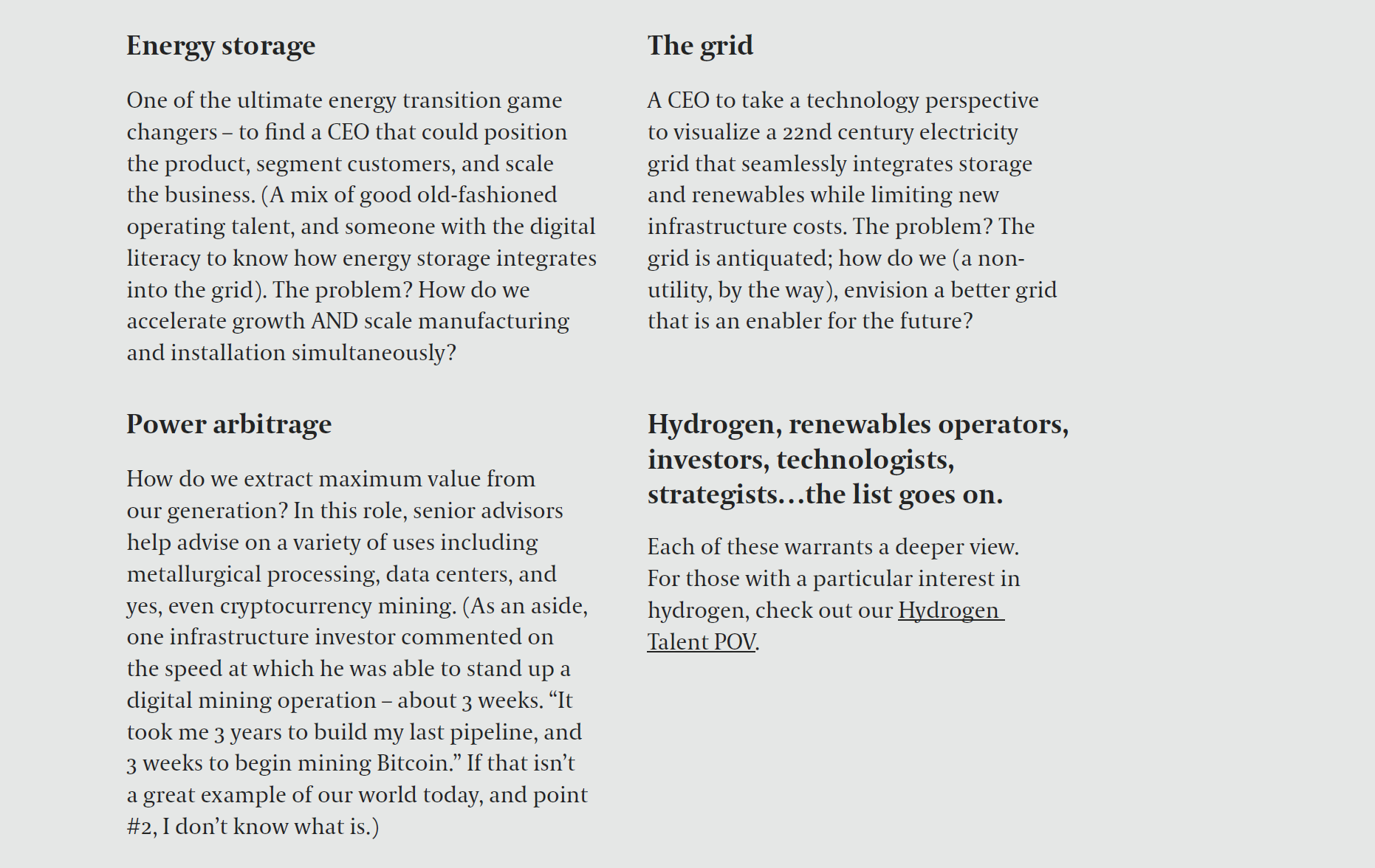The clean energy transition is accelerating at an unprecedented pace, fueled by climate urgency, technological disruption, and capital investment. Across power grids, transport systems, supply chains, and business models, the energy and utilities industry is being reinvented in real time.
But amid all the focus on decarbonization, digitalization, and decentralization, one element is still underleveraged: human leadership.
The truth is that clean energy transformation is not simply a technological or financial challenge. It is a human one. And success will depend not only on building infrastructure, but on building the leadership capacity to match.
Why Human Talent is Essential to the Clean Energy Transition
Why Human Talent is Essential to the Clean Energy Transition
The energy transition is redefining the very DNA of the industry. What was once a world of molecules—physical commodities, extraction, and asset-heavy operations—is now shifting to electrons, bytes, and distributed systems. The sector is being reshaped by digitalization, decarbonization, and decentralization.
This shift calls for a radically different leadership profile:
- In the past, energy success hinged on operational discipline and capital efficiency.
- Today, speed, agility, and systems thinking are the new differentiators.
- And in the future, leadership will be judged on results, resilience, ESG impact, and adaptability.
While investment in clean technologies is growing rapidly, the pipeline of talent equipped to lead in this new environment has not kept pace. The result? A growing leadership gap in a time of urgent transformation.
The Energy and Utility Industry’s Talent Crisis
The Energy and Utility Industry’s Talent Crisis
Capital is no longer the constraint. Talent is. Skill shortages are emerging across key sectors of the clean energy economy:
- Renewable generation (solar, wind, geothermal)
- Traditional gas fired generation (thermal renaissance, anyone?)
- Grid modernization and storage
- Electric vehicle infrastructure
- Hydrogen and carbon solutions
- AI, data, and digital grid optimization
The problem isn’t just a lack of technical specialists but also a lack of adaptive leaders who can operate across functions, translate between sectors, and lead amid volatility.
In many cases, companies are deploying creative stopgaps, including senior advisor appointments to inject near-term expertise, aggressive retention strategies, including double-digit salary adjustments, or redeployment and upskilling, especially for roles with transferable experience
But these are short-term fixes.
Long-term competitiveness requires building systems for identifying, nurturing, and retaining future-ready leadership.
A New Model for Leadership in Clean Energy
A New Model for Leadership in Clean Energy
In this fast-changing environment, traditional approaches to executive assessment are no longer sufficient. Resumes don’t predict agility, and tenure doesn’t guarantee adaptability. That’s why Egon Zehnder uses the Potential Model, a framework designed to identify leaders who can grow into tomorrow’s challenges, not just succeed in today’s roles.
4 Leadership Traits for the Clean Energy Transition
4 Leadership Traits for the Clean Energy Transition
In the context of the clean energy transition, potential is no longer a nice-to-have—it's the new killer app. The complexity, speed, and volatility of today’s energy landscape demand leaders who can grow into the future, not just operate within the bounds of past experience.
So, what does high potential actually look like?
After decades of working with energy and utilities organizations around the world, we’ve developed a clear and validated framework for identifying leadership potential—especially for those tasked with scaling new business models, entering uncharted markets, or bridging legacy operations with future-facing innovation.
It comes down to four core traits:
- Curiosity: A relentless drive to explore new ideas, challenge conventional thinking, and remain open to change. High-potential leaders exhibit intellectual agility and the hunger to learn fast, an essential trait in an industry undergoing constant reinvention.
- Insight: The capacity to synthesize complex information, spot patterns before others do, and deliver clarity amid chaos. These are the leaders who can decode shifting market dynamics, foresee implications, and craft compelling strategies rooted in real foresight.
- Engagement: The ability to connect deeply with others, mobilize purpose-driven teams, and align diverse stakeholders behind a shared vision. In a landscape where cross-sector collaboration is essential, engagement becomes a competitive advantage.
- Determination: The resilience to persist through setbacks, navigate ambiguity, and continue moving forward despite systemic disruption. The energy transition will test even the most seasoned executives; determination separates those who adapt from those who retreat.

We worked with a major energy company to systematically assess potential across its top leadership tiers. The outcome wasn’t just a sharper view of today’s strengths, it was a complete reorientation of roles, succession planning, and development initiatives based on who could shape the future, not just who had succeeded in the past.
Embedding a Human-Centered Talent Strategy
Embedding a Human-Centered Talent Strategy
Many organizations still treat talent as a support function. But in the clean energy transition, talent is strategy. A human-centered approach to transformation requires:
- Viewing leadership as a core pillar of energy strategy, versus just an HR initiative
- Aligning development with the three defining forces of the sector:
- Decarbonization: Navigating new markets, technologies, and regulations
- Digitalization: Harnessing data and automation for real-time optimization
- Decentralization: Managing distributed assets, workforce, and innovation
Importantly, leadership must evolve as quickly as the technologies and policies it supports. Otherwise, even the most ambitious energy strategies risk faltering under outdated organizational models.
Actionable Strategies for Organizations Navigating the Clean Energy Transition
Actionable Strategies for Organizations Navigating the Clean Energy Transition
The leadership gap in the clean energy transition is real but not irreversible. Organizations that recognize human capability as a strategic asset are already taking deliberate steps to capitalize on it.
This requires more than isolated initiatives or reactive hiring. It calls for an integrated approach to identifying, developing, and deploying leaders who can navigate ambiguity, embrace complexity, and mobilize transformation at scale.
Here’s how forward-thinking companies are building leadership pipelines designed for the future:
Audit for Potential, Not Just Credentials
Audit for Potential, Not Just Credentials
Traditional leadership assessments often prioritize tenure, technical experience, or industry pedigree. But in a sector evolving as quickly as energy, these alone are no longer reliable indicators of future readiness. High-performing organizations are using behavioral science and data-backed frameworks (such as Egon Zehnder’s Potential Model) to assess for:
- Learning agility
- Resilience under pressure
- Systemic thinking
- Leadership versatility
By shifting the lens from what leaders have done to what they are capable of becoming, companies can surface untapped talent – both internally and externally – and reorient succession planning toward future-state challenges.
Build Cross-Functional Learning Ecosystems
Build Cross-Functional Learning Ecosystems
The clean energy transition touches every corner of the business from engineering to finance, digital to regulatory affairs. Yet many leadership development paths remain siloed. To close the gap, companies are:
- Rotating leaders across disciplines and business units to build strategic range
- Embedding stretch assignments that expose individuals to unfamiliar environments
- Encouraging cross-sector mentorship, especially between legacy and emerging energy domains
These ecosystems create the conditions for innovation and unlock a new kind of versatility—one that’s critical in a world where boundaries between energy, mobility, technology, and infrastructure are increasingly blurred.
Elevate ESG Fluency Across Leadership
Elevate ESG Fluency Across Leadership
ESG is no longer a compliance function—it’s a core leadership competency. Leading organizations are embedding ESG expectations across all stages of the talent lifecycle:
- Baking ESG fluency into job specifications and executive searches
- Evaluating candidates’ ability to engage diverse stakeholders, manage environmental risks, and articulate purpose
- Investing in development programs that build awareness around climate policy, sustainable innovation, and inclusive governance
This elevates ESG from a niche requirement to a universal leadership imperative, driving better decision-making, stronger reputations, and greater long-term value creation.
Use Behavioral Science to Drive Decisions
Use Behavioral Science to Drive Decisions
The clean energy landscape is too complex and too fast-moving to rely on gut instinct in leadership decisions. Instead, organizations are turning to data and validated assessments to measure:
- Inclusive leadership behaviors
- Emotional intelligence and interpersonal influence
- Long-term orientation vs. short-term optimization
- Cognitive agility and openness to change
These insights allow organizations to design more equitable, resilient, and high-performing teams, aligned to the unique challenges of transformation.
Spot and Nurture Emerging Leaders at Every Level
Spot and Nurture Emerging Leaders at Every Level
Waiting for the C-suite to open up is too late. The real leadership pipeline is being shaped now—two or three levels below the executive tier. Companies leading the way are:
- Conducting talent reviews that focus on potential, not just performance
- Assigning real accountability to high-potential leaders in critical initiatives
- Creating accelerated development tracks that blend coaching, exposure, and peer learning
This approach builds capacity and increases retention and engagement, especially among diverse and next-generation talent who want to grow with the mission.
Additionally, these leaders should be focused on addressing today’s most prominent clean energy challenges [see graphic below for a sampling of problem solvers we have found. The challenges are complex and the opportunities are really interesting.

Human Power as the Engine of the Energy & Utilities Future
Human Power as the Engine of the Energy & Utilities Future
At its core, the clean energy transition is about solving the world’s most complex and pressing problems. And problem-solving is a deeply human endeavor.
The organizations that will lead this transformation will be those that invest in people as deeply as they invest in infrastructure. Those that:
- Treat talent as their primary competitive advantage
- Develop leadership pipelines that bring a wide array of backgrounds and are inclusive and adaptive
- Build cultures where curiosity, insight, engagement, and determination thrive
Because when it comes to energy’s future, human power is the engine of innovation, resilience, and sustainable growth.
If your leadership pipeline is built solely on past credentials, you’re flying blind into the future.
Now is the time to ask:
- Who in your organization demonstrates real potential?
- How are you cultivating that potential today?
- Are your CEO succession plans based on where your business was—or where it needs to go?
- Who are the rising leaders two or three levels down with the capacity to not just survive the energy transition, but to solve it?
In the clean energy era, the winners won’t be those with the most assets. They’ll be the ones who know how to unlock and scale human potential, at every level of the organization.
And if you need help with all of this, Egon Zehnder is here to support you.
Is Your Leadership Team Ready for the Clean Energy Future?
Is Your Leadership Team Ready for the Clean Energy Future?
The clean energy transition is unfolding faster than most organizations are prepared for. Success will hinge not on capital or technology alone, but on whether your leaders have the vision, agility, and resilience to drive transformation at scale.
At Egon Zehnder, we partner with energy and utilities organizations to identify, accelerate, and unlock the full potential of leaders who can thrive in disruption and build sustainable advantage.
The transition won’t wait and neither can your leadership strategy.
Now is the moment to invest in the people who will power your future.





